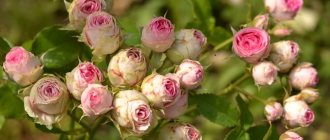Rose Robusta is bright, beautiful, showy and absolutely winter-hardy. She is also known under the name KORgosa. This rose belongs to the so-called group of park roses. The wide petals partially overlap each other, and from a distance the rose looks like a double rose. Looks very impressive in garden design. Rose Robusta was bred by the world-famous company Wilhelm Cordes and Sons. It was these breeders who obtained the most winter-hardy varieties of roses suitable for our climate. Growing and caring for Rosa Robusta roses does not present any difficulties. The variety is unpretentious, tolerates almost any weather and soil conditions, and is also shade-tolerant. Therefore, Robusta roses can also be grown by beginner rose growers. Practicing florist and author of the YouTube channel “Garden for the Soul” Svetlana Samoilova provided our website with her recommendations, time-tested and personal experience.
Caring for a park rose
In order to provide proper care for the bushes, no complicated actions are required.
Watering
Robusta needs to be watered only once every 10 days, but quite generously - about 1.5-2 buckets per adult plant. Watering is carried out at the root within a radius of 20-50 cm from the base of the bush. The earthen lump should not dry out. About 5 days after watering, the ground around it needs to be loosened for better air circulation.
Important! The crown does not need irrigation. The tree trunk circle within a radius of 60 cm requires timely removal of weeds and weeding
The tree trunk circle within a radius of 60 cm requires timely removal of weeds and weeding.
Well-groomed Robusta bush
Fertilizer
Robusta rose responds very well to fertilizers. The main fertilizers are compost and humus. Such fertilizing takes place once a year in the first half of summer; this is done by mulching, followed by application to the ground during loosening.
Do not forget about liquid feeding, which is done 2 times a season, the first time in May, and the second in August. For this, mullein is used, diluted in 100 liters of water and infused for 2 weeks. Approximately 10 liters of this infusion are added to one bush.
Prevention
To avoid infection of the bush during periods of high humidity, preventive spraying with fungicides is carried out no more than once every 3 weeks.
Trimming
Pruning is usually done after wintering in May after the young leaves have unfurled. Everything that was damaged by frost or simply dried out is removed and cut down to healthy wood. The park rose needs anti-aging pruning at the age of 5-9 years. To do this, all trunks older than 5 years are removed at the root. This should be done in the fall, from September to October.
Important! Prune the plant before wintering, removing all damaged or diseased branches.
Transfer
The most favorable period for transplanting Robusta roses is early spring or late autumn. Transplanting at another time entails not very pleasant consequences. But if an urgent need arises, then you will need to help the plant take root in a new place.
Preparing for winter
Despite the fact that the Robusta rose has good frost resistance, it is still worth helping it cope with the cold. Although the bushes are pruned before wintering, you still cannot shorten the branches too much - this can weaken the plant, and the rose simply will not survive the winter period.
To prepare for cold weather, you can create a simple ground structure above an adult bush from polyethylene or any other non-fabric material. Younger plants can simply be bent to the ground and covered tightly with spruce branches.
Step-by-step instructions for autumn pruning roses
Rose Lovely Green: a greenish-cream beauty in your garden
Beginner gardeners do not know how to care for climbing roses in the fall and whether they need to be pruned for the winter. We have found out that this is necessary, now let’s talk about how to do it.
First of all, you need to understand that the pruning tool must be sharp and always disinfected.
For diving you need to prepare:
- saw (garden);
- lopper for thick branches;
- thick gloves to protect hands;
- garden var;
- rake.
Dive:
- Make sure the weather is dry and sunny on the day of pruning.
- You need to prepare a sharp tool.
- For proper development, it is necessary to maintain proportions. The length of the roots will be equal to the length of the above-ground part.
- Thick branches need to be trimmed with a lopper.
- The entire damaged area of the wood should be removed. Usually the central branches are cut off, reaching the healthy zone (green bark with a white cut).
- It is necessary to pick over the outer, unopened bud.
- The cut must be made obliquely. This is necessary so that moisture drains 1 cm above the outer bud.
- All cuts after diving must be treated with garden varnish, and the plant is treated with copper sulfate.
Advantages and disadvantages of Robusta roses compared to other varieties
Dense and low bush fencing
As for the disadvantages of Robusta roses, they are practically absent, which is why the culture has become popular among flower growers. But, at the same time, we can highlight a number of significant advantages that make the rose worthy in relation to other plants:
- The area where Robusta roses are planted is an undeniable decoration of any garden.
- With the help of a dense and low fencing made of bushes, you can decorate not only your summer cottage, but also any public place, park or alley.
- In addition to being used for decorative purposes, roses are often used in cooking. So, from the petals of the plant they make delicious tea and jam, which you can enjoy in winter.
- Cosmetologists often use rose as an aromatic material. With the addition of petals, you can take hot baths and also use them as face masks.
Having familiarized yourself with all the rules and recommendations regarding the proper care of the Robusta rose, you can grow plants that will delight you with their unique flowering when spring comes. All the efforts of both an experienced and a novice gardener, which will be invested, will certainly lead to the desired result. As a reward for his diligent work, the florist will certainly be rewarded with red and unique buds.
https://pocvetam.ru/sadovye-tsvety/rozy/robusta.htmlhttps://www.prorozy.com/pink-robusta/https://7ogorod.ru/cvety/roza-robusta.html
Use in landscape design
Rose Big Purple - description of the varietal plant
Rosa Robusta belongs to the garden crops. It is convenient to use in any type of green building, including:
- creating a hedge;
- container culture;
- single landings;
- vertical gardening;
- planting in groups with both roses and other plants;
- design of borders, flower beds and rocky gardens.
It is important to note! Park rose Robusta is an excellent solution for any type of landscape design due to its unpretentiousness, brightness and amazingly long flowering.
Recommendations for agricultural techniques for growing and caring for Robusta roses
Gardeners who are just starting to grow rose bushes are very often interested in what differences exist in the agricultural technology of one or another plant variety. So, there are practically no differences, except that the pruning of Pink Robusta should be deeper in relation to other varieties. This is caused by the lush growth of rose bushes, both in height and width.
Growth and reproduction of the Robusta rose
The growth and reproduction of Robusta roses is possible even in areas where the soil is not rich in composition. But in order for the plants to grow and develop well, the soil must first be prepared for planting. Preparatory activities include the following items:
- Preparation of planting holes, the size of which should be 70*70 cm. A small amount of fertilizer should be added to the soil (some experienced gardeners use ready-made mineral complexes, for example, Kemira Universal).
- As for feeding consumption, it should be no more than 100 g per bush (provided that a group method of planting Robusta roses is planned).
- Before planting seedlings in the ground, their root system must be soaked in a growth stimulant for 3-4 hours in order to ensure active development and growth of the plant.
- At the bottom of each planting hole you need to pour a thin layer of drainage from small pebbles or expanded clay.
- The seedlings must be carefully placed in the hole and then covered with soil. At the end of planting, the planted roses must be watered abundantly and the ground around the seedlings must be mulched.
Important! Robusta roses need to be pruned in the spring or autumn. With the onset of spring, it is necessary to remove those shoots that have dried out or frozen, leaving only 7-8 strong cuttings
In the autumn season, diseased and too long branches need to be pruned, and all rose bushes should be carefully examined for the presence of fungal diseases. It is worth remembering that you need to inspect the rose regularly, as this will help to detect harmful insects or any disease in time.
Fungal diseases
In order for rose bushes to survive the winter well, they must be properly prepared for wintering. Beginning flower growers need to know that cutting the branches of powerful shrubs too short for the winter is strictly prohibited. This can lead to weakening of the plant, which will subsequently lead to a lack of buds in the spring. Before the onset of frost, the branches need to be slightly bent to the ground, and spruce branches should be placed between them. If weather forecasters predict a too cold and harsh winter, then it may be necessary to build a small frame to cover the plantings of Robusta roses.
general information
Rose "Robusta", the description of which we present to you, is a low shrub. Its height can reach one and a half meters. The flowers are painted in a red hue, and it is so rich and bright that it cannot be ignored, no matter where they grow. The structure of the buds is smooth, non-double, with uneven edges. The flowers have an elongated shape with many stamens in the center. Usually on a bush the buds are arranged in groups of five to ten in the form of bunches. The entire bush is strewn with thorns. And the thorns are so sharp and long that it is impossible to work with the plant without protective equipment.
Another notable feature of the Robusta rose is its gorgeous green foliage. It is thanks to this quality that the shrub is often used as a living fence. Large leaves harmonize perfectly with bright flowers. As for capriciousness, the plant is considered unpretentious. It can grow quietly in the shade, develop on a variety of soils and does not require any special conditions. Robusta (rose) blooms throughout the summer and autumn. The only disadvantage of this type is the lack of aroma. It is so weak that it is almost impossible to catch it.
Problems and their solutions
Park roses, the planting and care of which are described in this article, may suffer from attacks by all kinds of pests. And although the plant has sufficient and strong resistance, it does not have absolute protection. What problems are possible? Let's list some of them:
- Dark spots are the appearance of similar formations on the leaves. They turn yellow and wither. What to do in this situation? It is necessary to remove leaves affected by the disease. And treat the entire bush with a solution containing zinc and copper.
- Powdery mildew. White dust appears on the leaves. It is very similar to flour. It is necessary to treat the bush with a fungicide, and then water it using mullein infusion.
- Rust is the appearance of red spots on the leaves. Mostly such formations are observed on the reverse side of the sheet. A fungicide will also help here.
- Aphid attack. The presence of a pest is noticeable to the naked eye, and it must be combated using any solution against these insects.
Diseases and pests
Rosa Schneewaltzer
Rose Robusta can be harmed by various diseases and pests. Despite the fact that the plant has high immunity, it does not have absolute protection. So, when growing this variety you may encounter the following diseases:
- Dark spots that appear on the foliage. Gradually, the leaves begin to wither and turn yellow, and they must be removed immediately. To avoid infecting other rose bushes, they should be sprayed with a solution containing copper and zinc.
Rose diseases - Powdery mildew, which forms on rose foliage as a white dust that looks a bit like flour. You need to spray the bushes with a fungicide, and then periodically water them with mullein infusion.
- Rust, which is red spots that form on the foliage. In most cases, this disease manifests itself on the lower part of the leaves, and it must also be combated with the help of a fungicide.
Both experienced and novice gardeners may encounter aphid attacks when growing Robusta roses. These parasites can be easily seen with the naked eye, and it is possible to get rid of them with the help of drugs such as Karbofos, Iskra bio and Fitoverm. Before using this or that product, be sure to read the instructions for use. An incorrect dosage can significantly harm the rose or even lead to its death.
Rose blossom
With the right agricultural technology, the Abraham Derby rose will delight you with its magnificent flowers for decades in a row throughout the summer months. At the height of flowering, the aroma of blossoming buds can be clearly heard from a distance of several meters.
Period of activity and rest
The first flowers open in the first ten days of June. The last of them can be cut off in the last ten days of September.
Care during and after flowering
To ensure flowering does not stop, it is important not to skip feeding, and be sure to cut off wilted buds, preventing the plant from wasting energy on ripening the seeds. What to do if it doesn’t bloom, possible reasons
What to do if it doesn’t bloom, possible reasons
This effect occurs when planting roses in the shade. If the bush has changed the color of the foliage to yellow-brown, then this indicates an acute lack of iron and magnesium, and urgent feeding is required.
Applications of roses
Various uses of the plant show that it is not only beautiful, but also useful:
- A flower bed with roses looks great as a decoration in any garden.
- A low but dense fence made of this bush will decorate not only your site, but also any public place or park.
- In addition to decorative, this rose is also used for culinary purposes. So, jam and tea are made from it.
- In cosmetology, the flower is used as an aromatic material. Its petals are also added to various baths and masks.
In conclusion, I would like to note that the shrub is so attractive that all the listed rules for care and propagation are worth the effort of growing the plant. After all, you will see all the efforts invested with the arrival of spring, when the rose blooms in your garden with beautiful bright buds.
Rose "Robusta". 10 advantages for which you will love Robusta
Articles / Plants / R
Few people know Robusta yet, but undoubtedly its shares are greatly undervalued, and will only grow. Here is just one argument in favor of such a statement. Having looked through several English rose-growing reference books and encyclopedias, you will certainly find this rose in the list of the most valuable varieties for the English garden. And this despite the fact that the mild climate of Britain allows us to ignore such an important characteristic of roses as winter hardiness. Meanwhile, it is precisely the extraordinary winter hardiness that opens wide open to “Robusta” not the gates, but the gates to any Russian front garden!
Planting and caring for Robusta roses
In addition to the scarlet beauty, there is also the Pink Robusta rose, which grows lower than the previous one and has larger flowers (up to 10 cm) of a soft pink color. Beginning gardeners, who are attracted to robustas, are often interested in whether agricultural technology differs when applied to different shrubs. There are no significant differences, except for pruning measures, which, in the case of a tall scarlet rose, is desirable to be deeper - due to the lush growth of the bush both in width and height.
As already noted, these persistent flowers can grow on soils that have a very modest composition, but for better growth, the soil should still be slightly refined.
Standard landing measures:
- a planting hole measuring 70x70 cm is prepared;
- a little fertilizer is added to the soil (you can use ready-made ones, for example, Kemira Universal or analogues);
- feeding consumption: one hundred grams for each bush (if group planting is planned);
- before planting, seedlings are placed in a root growth stimulator for three to four hours;
- the bottom of the hole is lined with drainage (expanded clay or small pebbles);
- the bush is carefully placed in the hole and gradually covered with earth;
- finally, abundant watering and mulching of the ground around the seedlings follows.
Pruning should be done in spring and autumn. In the spring you need to remove frozen and dried branches, leaving the strongest ones in the amount of seven or eight pieces. In the fall, too long and diseased branches are also pruned, and the entire bush is inspected for fungal diseases. However, inspection of the plant should be regular to avoid the appearance of both diseases typical of roses and harmful insects.
In order for roses to winter well, their proper preparation for winter is important. On the one hand, we are talking about a powerful shrub, over which, most likely, a frame structure will have to be built, so novice gardeners may be tempted to cut the branches much shorter. However, this should not be done, because over the winter the bush will weaken and may not bloom in the spring. Before wintering, it is better to bend the branches to the soil, laying branches of spruce branches between them and on top. And if the winter promises to be too cold, it is better to make a small frame and cover it on top with non-woven material.
Routine care for roses after wintering, in spring and summer, includes the following activities:
- regular watering twice a week;
- loosening and mulching the soil;
- timely removal of weeds;
- light cosmetic pruning of the bush to maintain its shape;
- preventive spraying with insecticides;
- preventive spraying with fungicides if the summer is rainy and cool;
- It is advisable to fertilize, but the main thing is not to overdo it, as the bush will quickly begin to wither and lose its decorative properties.
Beginner gardeners can also be trusted to grow Robusta - especially since it does not require too “rich” soil conditions, and the lack of minimal nutrients can be corrected by applying ready-made mineral fertilizers.
Rosa Robusta: unpretentious scarlet beauty:
Watering and air humidity
Rosa Mix loves regular but moderate watering. Moisten the soil as soon as its top layer dries, but do not overwater the plant. Due to the accumulation of moisture, the roots of the flower will rot. For the same reason, always pour out excess water from the pan. In winter, reduce irrigation to a minimum.
For irrigation, use melt or rain water at room temperature. If this is not possible, then regular tap water will do. But before watering, be sure to filter and let it sit for at least 2-3 days.
The miniature rose responds well to foliage spraying. Carry out such an event at least every other day. Spray the foliage with cool water from a spray bottle only in the evening.
Flowering and dormancy
Robusta begins to bloom in May, and after the first buds appear, it continuously generates new flowers. The most active flowering time occurs in mid-August - early September, and in the absence of cold weather, flowering will delight the eye in October. From this it turns out that the total flowering time lasts as long as 4-5 months.
The most important aspects in caring for a park rose during the flowering period are timely weeding and loosening of the soil. The petals of the buds do not wither, but fall off, so the rose bush will look attractive even in the process of flowering, which cannot be said about dense park roses.
Important! Robusta's dormant period begins in late autumn and lasts until mid-spring.
Why doesn't the rose bloom?
There are several reasons why a rose may not bloom:
- The first year after planting. The plant may not bloom at all. This depends on the source material used for planting. In the first year, it is better not to let Robusta bloom so that it takes root as well as possible.
- Incorrect care. The rose is quite demanding in terms of living conditions; it needs additional nutrition, as well as timely treatment against pests or diseases. If the bush has already begun to shed its leaves and looks sickly, most likely, you won’t have to wait for flowering. However, it is also not worth “overfeeding” the plant, since excessive feeding gives enough strength to the foliage, and flowering becomes rather sparse.
- Incorrect trimming. You should not subject Robusta to severe pruning or try to form a “small bush” - this leads to weakening of the plant. Such actions lead to a shift in flowering time, since the rose will need to recover after such procedures.
Ida Cordes! Come on, s-s-breeder!
The breeding plant has been a supplier of the most unpretentious garden roses for many years. Consider such masterpieces as the climbing roses “Flammentanz”, “Raubritter”, “Rosarium Utersen”. Or the floribunda rose “Schneewithchen” (aka “Iceberg”)... If we keep in mind our middle zone, then the backbone of amateur rose gardens here is made up of Cordes varieties.
The reference manuals are terse. About “Robusta”, for example, they say a few lines. That it appeared in Germany in 1979. That the mother plant was a wild rose (Rosa rugosa), which was fertilized with pollen from a seedling of unknown origin. What kind of seedling it was, not a word. But it’s a no-brainer that the breeder will not cross just anyone with whomever he has to.
Since nothing similar to rugosa is found in “Robusta,” a natural conclusion arises that it inherited its features from an unknown pollinator. And it’s just as obvious - it was an extraordinary specimen. After all, what was born from this “father” is clearly superior to the wild mother in all external indicators. But with its outstanding frost resistance (4USDA), “Robusta” turned out to be exactly like it.
But everything is in order.
Extraordinary winter hardiness. The winter hardiness of “Robusta” allows you to grow it without cover, and even without bending it down, up to the 4th winter hardiness zone. That is, wherever the average winter minimum does not exceed minus 34°C. This is in absolute snow-free conditions and without bending down. With bending down, and even more so with shelter, and in colder regions.
Powerful straight shoots, sharp thorns. The name of the variety itself is telling. “Robusta” translated from Latin means strong, powerful. Thanks to strong vertical branches, the shrub firmly holds its shape, does not break under snow, and does not fall apart in the rain. The strong shoots of the rose are abundantly strewn with sharp, “vandal-proof” thorns. The thorns, although numerous, are still not as thick as those of wild rugosa, and not brittle, but rather durable. If someone dares to grab a branch with his hand, he will be severely punished, and will no longer want to repeat his feat. Since the flowers of "Robusta" are very seductive, and it is most often planted in the open and without protection, the carnivorous teeth are very useful for it.
Shape and size of the bush. The height of an adult Robusta bush is 150-180cm, width 120-140cm. This height to width ratio corresponds to the park ideal.
Bright, unfading flowers. The flowers of “Robusta”, although simple, are unusually colorful. In any case, such flowers are very rare for park roses. Thanks to their brightness, they loom from afar, but in relative proximity they look like tea-hyrid. When they bloom, rose petals do not wither, but fall off. Therefore, the shrub does not lose its appearance, as often happens with densely double park roses.
Continuous flowering. The first flowers on "Robusta" appear in May. Having begun to bloom, the shrub continuously generates new and new buds. Maximum flowering occurs at the end of August - beginning of September. The rose blooms quite actively throughout September, and in the absence of frost, flowering continues into October. Thus, the total flowering time of “Robusta” can reach five months.
Elegant leaves. The leaves of "Robusta" are, without any exaggeration, extraordinary. Large, shiny, healthy, attractive deep green color. They simply cannot be ignored. Although beautiful leaves are not considered a significant advantage for roses, they undoubtedly benefit bush roses. Since Robusta produces flowers constantly, but in relatively small quantities, the leaves create a background against which the blooms appear more luxuriant.
Resistance to diseases and pests. "Robusta" is resistant to diseases and pests, for which it was rightly awarded the ADR reliability certificate.
Durability. "Robusta" appeared in Russian gardens relatively recently, so it was not possible to find out its life expectancy. But since 20-year-old Robusta bushes do not look “aged” at all, we can conclude that the service life of the bush exceeds 30 years. The longevity of “Robusta” is also supported by the fact that it is grown exclusively in its own root form.
Drought resistance. The rose inherited its drought resistance from rugosa. In the Moscow region, Robusta can survive any drought. Of course, you should not subject it to extreme tests, because this will inevitably damage the flowering.
Low maintenance. This quality is a direct consequence of the previous ones. There is no need to cover Robusta; watering and pruning are not burdensome. For the first few years, Robusta does not need pruning at all. And caring for shrubs mainly comes down to weeding and loosening the tree trunk circle.
Diseases, pests and ways to combat them
Despite its high immunity, Robusta can be exposed to some diseases and pests. Of the insects, the most dangerous for her is aphids. Regular treatment with insecticides will help get rid of it.
Aphid
Powdery mildew and rust can cause serious harm to the flower if measures are not taken promptly. Treatment with fungicides will help get rid of them.
To get abundant and lush flowering of the Robusta rose, it needs to be provided with proper care. In gratitude for this, it will become a real decoration of the garden plot.
Advantages and disadvantages
A large number of advantages have made the variety widespread among gardeners. The main positive aspects include the following:
- resistance to frost, which allows the use of minimal shelter for the winter period;
- long flowering, which begins in early spring and ends after the first autumn frosts;
- continuous opening of buds even with frequent precipitation or exposure to hot sun.
Considering the shortcomings, it is worth highlighting the lack of resistance to diseases and pests. Another disadvantage is that the branched shoots are covered with sharp thorns, so you have to use gardening gloves when caring for plants.
Robusta
The Robusta rose has been growing in our dacha for a good dozen years. The parents took the cuttings from their neighbors, envying the bright continuous flowering. In our holiday village this plant has gained popularity. Yes, that’s understandable. Summer residents mainly garden; there is not always enough time for painstaking care of capricious varieties.
But Robusta is very unpretentious. All care consists of feeding mullein along with other garden crops and pruning old and frostbitten branches in the spring. Only the first years were covered for the winter; now it spends the winter without shelter.
We cut it with a long-handled pruner, as the rose is very, very prickly.
Rose is very attractive, there are no indifferent people looking at her. The flowers are simple, but very beautiful scarlet. The foliage is dark green and quite large. We grow it as a free-standing bush, some neighbors grow it as a hedge. It looks beautiful, but, of course, there is more care involved in pruning and treatment against fungal diseases. When planted in masses, black spotting is more common on Robusta.
Application in garden design
Fairy tail rose encyclopedia of roses. ground cover rose “the fairy”
Our streets and city yards are still without roses. Unless, however, you count the dog rose and wild rugosa. But these are all surrogates. For us, real roses remain a “bourgeois luxury.” Meanwhile, European breeders have already created several fairly winter-hardy park roses, designed to replace the rose hips that are boring everyone.
"Robusta" could mark the beginning of the "modernization" of public gardening. Especially now, when landscaping has become a profitable business, and the designer is financially interested in good reviews. Bright, continuously blooming all summer, reliable. Where have you seen such a combination!
In Europe, “Robusta”, by the way, can most often be seen not in the front garden itself, but next to it - in the landscaping of the street near the house, in parks, in city courtyards, near public buildings. We still hide such roses away. But times are changing, and it’s time to move to other landscaping standards. “Robusta” would just help to take a small step in this matter.
There would be enough work for her. First of all, private landscaping in all forms. As a reliable and continuously blooming plant, “Robusta” can be recommended for the most important public places: memorials and monuments, temples and monasteries, educational institutions and scientific institutions, private shops and offices, administrative buildings and all kinds of offices.
Single bush. A single Robusta bush can be planted not only on the street in front of your house, but also as the central figure of a separate composition. The base of the bush can be sodded with perennial ground cover (Gautier fescue, tenacious) or several boulders can be placed at its base.
Flowering hedges. Row plantings are already a classic use of Robusta. The British give her this particular specialization. When describing a rose in English manuals, it is emphasized that breaking through a Robusta hedge does not even occur to a cat. As for attacks on flowers, the rose is able to fend for itself.
Rosa Robusta description and characteristics
Rose Robusta is a small bush, which is only 1.5 meters high and 1.2 meters wide. What distinguishes this variety from others?
Separate Robusta bush
Among the main characteristics and features are several:
- This variety is characterized by rich, bright green, large leaves, which serve as a kind of frame for the variegated buds of the Robusta rose.
- The buds are not double, scarlet, symmetrical with a small bunch of stamens that are difficult to notice. They open from elongated buds, on which short racemes subsequently appear, producing from 5 to 10 flowers.
- Flowering is abundant and continuous. It begins in mid-spring and ends with the first frost. Neither direct sunlight nor rain harms the buds.
It is important to note! Rose Robusta is distinguished by very prickly shoots; literally the entire bush is strewn with long thorns. That is why all work with the plant must be carried out with protective gloves to avoid injuries and cuts.
Photo and description
Ficus robusta: description, photo, features of care and cultivation
Rugosa is a spreading shrub. Depending on the variety, its size can reach a height of 45 to 210 cm. Annual plants have green, grassy shoots, while perennials are woody brown. Contains spines: small, needle-shaped and large, widened at the base.
The odd-pinnate leaves with stipules and petioles have an alternate arrangement. From 7 to 9 pieces of leaves are located on one petiole. The shiny green surface of the leaves is oval in shape with jagged edges, in contrast to the lower surface, which is pubescent and gray in color.
Depending on the species, the flowers are single or collected in inflorescences of 2-4 on a peduncle. The color scheme is varied: white, yellow, pink, red, etc. Fragrant flowers are five-membered and actinomorphic.
The spherical fruit of Rugosa in the form of a prefabricated nut is covered with a pericarp. Ripe fruits are red or orange. The plant grows underground woody shoots - turions, forming a caudex.
Propagation of the Robusta rose
The easiest way to grow the required number of strong rose seedlings is by vegetative method. To do this, you can divide the bush, root the always available offspring or cuttings. In early spring, before the buds open, you can sprinkle several shoots with soil. They take root easily, and by autumn they have their own root system, which can ensure active growth of the bush next year.
In order for the abundantly flowering Robusta rose bush to delight its owner with bright red flowers for many years, it is necessary to fulfill a number of requirements for its care. And this is the right site for planting, the presence of a healthy seedling, watering, fertilizing, pruning, pest control. Roses also love it when people just talk to them.
Park rose Robusta: description, history of creation
Rose Robusta is a hybrid plant. It was obtained in a German nursery through the efforts of the Cordes family of breeders. The new species was first described in 1979.
Rose Robusta
Additional Information. Of the 20,000 varieties of roses currently existing, Robusta is the longest-flowering and low-maintenance bush.
Robusta is a shrub 1.5 meters high and 1.2 meters in diameter. The main differences between this variety and its counterparts are:
- Large, bright green leaves that frame rose flowers.
- The buds of the park rose Robusta are red or scarlet, with small stamens. Blooming flowers form inflorescences of 5-10 pieces.
- Flowering of Robusta begins in mid-spring and ends with the onset of the first cold weather. The buds bloom abundantly and continuously. They tolerate both bright sunlight and rain well.
Interesting information. Robusta has very prickly shoots - literally their entire surface is strewn with needles. You must wear gardening gloves when interacting with it.
Advantages and disadvantages
This culture has no significant disadvantages. Even with minimal care, it will not cause problems in cultivation. The advantages include the following:
- abundant and continuous flowering;
- can grow in almost any soil;
- calmly tolerates various weather conditions;
- has high frost resistance;
- has immunity to fungal diseases.
Use in landscape design
Garden roses are often used in landscape design. It is used for the following landscaping options:
- in groups with other plants or single plantings;
- for creating green hedges and borders;
- creating rocky gardens and flower beds.
Robusta in landscape design
Agricultural technology.
Rose "Robusta" is relatively drought-resistant and undemanding to soil conditions. But the best development, and therefore the highest decorative effect, like any other rose, is achieved in a favorable agricultural background.
Landing place. The soil. Open sun or light temporary partial shade. The soil is light or medium loamy, deeply cultivated. Pit size when planting: depth = 50-60cm, diameter = 60-70cm.
Soil mixture options:
Turf soil, humus, sand 2:1:1 or 2:2:1
Turf soil, leaf soil, humus, sand 1:1:1:1
Care. Fertilizer. Watering. The tree trunk circle (within a radius of 60-90 cm) is kept free from weeds. Weeding is best done with a hoe or flat cutter, combining it with shallow loosening.
It is responsive to fertilizer. It is advisable to apply the main fertilizer (humus or compost) once in the first half of summer using the mulching method, with gradual incorporation into the soil during loosening.
During the season it is useful to carry out 1-2 liquid feedings. To do this, two buckets of mullein (or 2-3 tightly packed buckets of cut grass) are sealed in a 200-liter barrel and left to ferment for 12-15 days. It is advisable to carry out the first feeding in early May, and the second in July-August. For an adult bush, 15-20 liters of infusion are consumed.
Regular watering is a necessary condition for the normal development and abundant flowering of roses. It is recommended to keep the root ball in a constant, moderately moist state. Watering is indicated at the root, without irrigating the crown, moistening the soil within a radius of 25-40 cm from the center of tillering. A particularly important period is July-August, the time of laying new flower buds responsible for the future “harvest”. In years with normal precipitation, it is enough to water Robusta once every 10 days, but generously - about two buckets per adult bush. 6-7 days after watering, it is useful to disturb the soil crust by loosening.
Trimming. The most dramatic is anti-aging pruning. The need for it usually arises only at 6-8 years of age. It comes down to the systematic removal “at the root” of old (over 5-6 years old) trunks. It is advisable to carry it out in the fall in September - early October.
After harsh winters, young growths may be damaged. The dead parts are shortened to healthy wood. It is recommended to do this after the young foliage has fully expanded, in mid-to-late May. The task of formative pruning is to give the crown of the bush density and compactness. To do this, shoots that are actively leaving the contour you have outlined are systematically blinded and shortened.
Reproduction. Since “Robusta” is grown only in its own root form, it is propagated by green cuttings. Cuttings are cut at the beginning of lignification, from late June to mid-July.
Where and how to choose seedlings
It is better to purchase Pink Robusta rose seedlings from well-established nurseries, shortly before the planned planting. The shoots should be free of spots and blackened areas. It is better if the buds are only slightly hatched. The root should not be dried out. The cut should be white. When purchasing a seedling with a closed root system, the substrate must be moist.
By planting a Pink Robusta rose and performing simple steps, the gardener will receive a gorgeous bush that blooms for a long time and abundantly.
Pink Robusta
Main characteristics.
Pink Robusta is a budding rose grower's dream!
Pink Robusta is a hybrid of the rugosa rose up to 2 meters high. Average height 1.3 - 1.5 m. Originator: Kordes, 1986.
Pink Robusta is a reliable comrade and friend who will never let you down.
Rosa Pink Robusta fits the name “ideal”. What is it about? About her super abilities, of course! It is distinguished by its special winter hardiness, long flowering period and the beauty of the bush. Yes, and, finally, its pure pink color is also an indisputable advantage of the variety; this color is the most traditional and understandable for everyone.
Bloom.
Pink Robusta has luxurious semi-double pink flowers with slightly wavy petals. The flower size is 8-10 cm, collected in loose clusters of 5-7 pieces. The rose shows a light, almost white center with golden, densely spaced stamens. This white bottom with a golden border gives the variety a special attractiveness, especially since the flowers are also fragrant. Their scent is light, airy, citrusy.
A powerful rose bush with thick, very prickly shoots
The spines are located frequently and literally “cut with a knife” if you touch them carelessly
The green mass consists of equally healthy leaves of a deep dark green color, sometimes a slightly reddish tint, which makes the color of the leaves appear even darker in their mass.
Good for hedges, “tolerates” other more “complex” roses nearby, being an excellent background for them.
Pink Robusta is very popular in urban landscaping in many countries around the world. Its hardiness, impressive size, general decorative qualities, as well as ease of care, excellent winter hardiness and, finally, long flowering are the key to the stable success of the variety for many years to come!
Description
Flowers open from elongated buds and appear in short racemes of 5-10 pieces. The bush is very prickly - the shoots are so often strewn with long thorns that it is impossible to handle them without thick gloves. Large, bright green, wrinkled foliage is a beautiful frame for scarlet flowers. Grows well in poor soils and is very winter-hardy.
A vigorous bush with dark leathery foliage and thick prickly shoots, reaching 1.5 m. The flowers are single, fragrant, bright crimson-red, initially cupped, with wavy petals. It blooms very profusely all summer and autumn. A hardy variety that tolerates almost any weather and soil conditions, and is shade-tolerant. Robusta makes a wonderful dense hedge.
Bushes of this rugosa rose hybrid planted in a row form an impenetrable hedge. The rose is erect, dense, very prickly, covered with large, shiny dark green foliage, impervious to diseases. It blooms in May, the first wave of flowering is followed by several more. The flowers are large, non-double, crimson. They tolerate rain well, but have almost no smell.
Not all roses have the ability to continuously produce more and more new flowers. Many, after a wave of early summer blooms, enter the summer heat dressed only in greenery. Robusta belongs to those elite roses that bloom almost continuously. Although Robusta's flowers are simple, their size and bright red color allow them to stand out.
This is a truly hardy rose and is easily propagated from green cuttings. The very spiny shoots form a tall, upright bush well suited for edging shorter plants. The combination of large, textured dark green foliage and wine-red shoots also looks very flattering. Delicate fruity aroma. In winter, without shelter, it usually freezes by about 50%, but it grows quickly and blooms profusely by mid-July.
The flowers are dark red, large, simple, collected in small dense inflorescences. Used to create high (up to 2 m) fences along land use boundaries. (For more details, see Tsvetovoda Bulletin, No. 5, May 2005. Galina and Olga Pankratov. “We say “park”, we mean...”)
Growing a flower
It is better to plant a rose using a seedling rather than seeds. To plant the plant, you should use an area that is well lit in the first half of the day and becomes slightly shaded in the second half. Sunlight has a positive effect on the brightness of the color of the buds and the flowering process.
Note! The selected area should not be characterized by drafts and strong winds. However, the area should be well ventilated
You cannot grow the flower in rainy regions. Dampness will have a negative effect on it, the petals will droop.
Hybrid tea rose Big Purple requires fertile soil. It needs to be planted in loam enriched with nutrients or chernozem. The best indicator of soil acidity is 5.6-6.5 pH. Swampy areas are unsuitable for this variety as it will grow poorly and be susceptible to disease. Groundwater should not exceed 1.5-2 m from the surface.
Important! You can make the soil more fertile before planting. It is recommended to add peat, rotted compost and sifted river sand to the clay medium
For sandy soil, compost made from peat and manure and turf are suitable. If the soil is highly acidic, the area is limed.
Seedlings with a closed root system are selected as planting material. They are sold in gardening nurseries. The plant should not show mechanical damage, traces of insects or symptoms of diseases.
Landing
This rose bush is planted in the spring in mid-April. Before planting, the seedling is immersed in a solution of potassium permanganate for a day, which accelerates root growth. Additionally, you can use root. Roots that are too long or damaged are removed with pruning shears down to the healthy part of the plant. Instructions on how to plant a rose seedling:
- Dig a hole 60 cm deep.
- Place a drainage layer at its bottom - small pebbles, crushed stone or gravel with a thickness of 10 cm.
- Lower the seedling into the hole, straightening the roots and pointing them down. Planting of several seedlings is done at a distance of 1 m from each other. The neck of the seedling should be deepened by 15 cm.
- Fill the hole with soil, compact it a little, and water generously.
For your information! After 2-3 days, the soil needs to be loosened to a depth of 3 cm, and the bush should be hilled up to the level of cutting the shoots.
Soil and pot
For homemade rose Mix you need special soil, which can be bought at a flower shop. To make your own substrate, mix turf soil with peat and sand in a 2:2:1 ratio. But be sure to disinfect the mixture before planting. Otherwise, the plant will suffer from pathogenic microbes living in the soil. Before the event, add some granular fertilizer to the mix.
Rose Mix takes root better in ceramic pots with a glazed surface. Their dimensions should exceed the volume of the roots by no more than 2–3 cm. And the pots should also have drainage holes. Before the event, it is advisable to soak such containers in warm water for 2 hours. Then the material will be saturated with moisture and will not then draw water out of the soil.
Rose Robusta description and characteristics of the variety
Rose Robusta is a small shrub that can reach only 1.5 m in height. This variety can be distinguished from other representatives of elegant roses by the following characteristics and features:
- symmetrical and neat scarlet buds, with small stamens, which are extremely difficult to notice with the naked eye;
Symmetrical and neat scarlet bud - the elongated shape of the buds, and after they bloom, they take the form of tassels, which often contain 5-10 flowers;
- large, rich green and wrinkled foliage, which acts as a wonderful contrast to the variegated flowers, giving the Robusta rose a unique beauty and unique charm;
- high level of winter hardiness, but if you choose the wrong area for planting the plant, it can be affected by various diseases and spotting.
The flowering of the crop, which begins in spring and ends with the first autumn frosts, is continuous and abundant. The buds are not afraid of direct sunlight and rain, but it is worth noting that they have practically no aroma.
With the help of low and strong shrubs, you can create luxurious hedges in an original way, which will become a real pearl of your garden plot. Rose Robusta looks advantageous both when planted alone and in a large garden bed, next to other plant and flower crops.
Note! The Robusta rose has prickly thorns, which is why it is recommended to plant and care for the plant wearing protective gloves to avoid injury to the skin of your hands. Before you begin a thorough study of the characteristics of this variety, you need to understand that the Robusta rose belongs to the scrub class of medium-climbing plants
With the help of the famous Rugosa variety, two unique varieties of the crop were obtained - the Pink Robusta rose and the Cordeo Robusta rose. The first one is distinguished by delicate pink flowers, large buds, and also not so long and sharp thorns. Cordeo Robusta is not so attractive, but due to its strong resistance, these two varieties are not afraid of parasite attacks and bad weather conditions
Before you begin a thorough study of the characteristics of this variety, you need to understand that the Robusta rose belongs to the scrub class of medium-climbing plants. With the help of the famous Rugosa variety, two unique varieties of the crop were obtained - the Pink Robusta rose and the Cordeo Robusta rose. The first one is distinguished by delicate pink flowers, large buds, and also not so long and sharp thorns. Cordeo Robusta is not as attractive, but due to its strong resistance, these two varieties are not afraid of parasite attacks and bad weather conditions.
General information about culture
The place where the Robusta rose was bred was a German nursery that belonged to a family of scientist-breeders named Cordes. The first mention of this variety dates back to 1979, which was recorded by botanists studying Robusta. The culture is one of the gardening representatives, and its ancestor is the ancient variety Rugosa. It was thanks to him that the Robusta rose received the title “wrinkled”.
For flower growers, growing the beautiful Robusta rose will bring nothing but pleasure, since the culture takes root well in almost any climatic zone of Russia. In addition to the fact that when planting you need to follow some rules of agricultural technology, caring for the plant does not present any difficulties.
Look, read:
1 comment on the article Pink Robusta
I agree that the rose is reliable and at the same time beautifully blooming, bright and large, hardy with beautiful shiny foliage. The bush is strong and powerful. In general, the variety is right for those who are looking for a strong, long-blooming rose without frills. Yes, the flowers are simple, but in full color the bush looks very elegant and respectable. I love old, English roses, but also hardy park roses for company and just for variety, for color transitions. Between double roses I plant roses with simple flowers of different sizes - it all looks wonderful! I recommend this variety to all rose lovers, which is suitable for all occasions. He will please, but not upset.
Winter-hardy varieties of other classes
Of course, the longest-blooming roses are not necessarily representatives of the well-known groups of varieties that we described above. Here are a few more interesting varieties for your attention, which can also surprise you with the duration and beauty of flowering.
Viridiflora
This unusual plant belongs to the group of Chinese rose hybrids. The green color of the petals may not be appreciated by everyone, but how original these neat branched bushes (100 cm high and 80 cm wide) look on the site! The flowers are small (5-6 cm) with pale pink spots. Viridiflora roses are also often used as a basis for bouquets.
Stacey Sue
A variety from the Miniflora group, or Patio. The neat bushes of this miniature semi-climbing rose reach 40 cm in height and bloom with small double flowers of a soft pink color. It grows excellently both in flowerbeds and in containers and has a pleasant aroma.
Rose varieties
The classification system for rose varieties is very complex, especially if we take as a basis not only the phenological characteristics of a particular plant species, but also the history of their origin. Thus, the famous Robusta rose has recently been assigned to the class of scrubs, unpretentious shrubs for northern gardens.
Sometimes they are called semi-climbing roses. This variety was obtained from the ancient rugosa or wrinkled rose in the nursery of Reimer Cordos in 1979. In Germany it was classified as a hybrid of the rose Rugosa. Bright red flowers adorn the huge bush throughout the season, covered with sharp thorns and dark shiny foliage. This is one of the most colorful rugosas.
On the basis of this variety, in 1986 the same breeder developed the Pink Robusta variety with delicate pink flowers with a white spot in the center. The height of the bush and the size of the thorns are smaller, but the flowers, on the contrary, reach 10 cm in diameter. They are very resistant to bad weather and powdery mildew. The Canadian variety Cordeo Robusta is interesting. All varieties of Robusta roses are frost-resistant and are most often used to create a beautiful hedge.
Just so you know.
Rose "Robusta" was bred (W.Kordes & Sohne) in 1979 from crossing wild rugosa with an unknown seedling of a cultivated variety.
The flower has a simple 5-petal corolla with a diameter of 7-8 cm. The wide petals partially overlap each other, and from a distance the rose looks like a terry rose. The leaves are large, the leaves are dark green, leathery, shiny.
ADR Certificate is a kind of “Quality Mark” awarded to rose varieties by an independent jury based on the results of their long-term testing for outstanding disease resistance.











